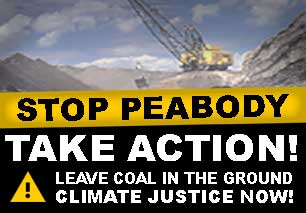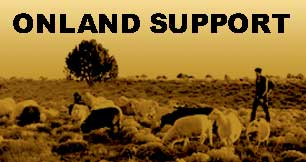FIRST NATIONS, FIRST RESISTANCE
September 12, 2009 by pathfinder
Filed under Latest Posts
FIRST NATIONS, FIRST RESISTANCE
A Snapshot of Life For Residents of the Big Mountain Regions of Black Mesa &
An Opportunity To Support Indigenous Resistance To U.S. Colonization in 2009
On behalf their peoples, their sacred ancestral lands, and future generations, more than 350 Dineh residents of Black Mesa continue to carry out a staunch resistance to the efforts of the US Government, which is acting in the interests of the Peabody Coal Company, to devastate whole communities and ecosystems and greatly de-stabilize our planet’s climate for the profit of an elite few. This land is the basis for the Black Mesa peoples’ traditions, livelihoods, and spirituality.
Indigenous nations are disproportionately targeted by fossil fuel extraction & environmental devastation and Black Mesa is no exception.
Black Mesa Project Controversy Rises
October 25, 2008 by pathfinder
Filed under Latest Posts
BLACK MESA, Ariz. – A push to approve a Peabody Western Coal Co. project in northern Arizona may be dividing the Hopi Tribal Council and fueling an attempted ouster of the tribal chairman.
Stop The Black Mesa Project: Peabody’s Massive Coal Mining Expansion Plans
October 11, 2008 by pathfinder
Filed under Action Alerts, Latest Posts, Mining & Water
Thank you to the many people who sent in your comments in opposition of the Black Mesa Project: Peabody Coal Company’s massive coal-mining expansion plans on the Dine’ (Navajo) & Hopi peoples sacred ancestral homelands of Black Mesa, AZ. The Black Mesa Project Draft Environmental Impact Statement is due out this December ’08. Please stay posted for updates during these critical times!
Big Mountain Update 2008
October 4, 2008 by pathfinder
Filed under Latest Posts
LIFE FOR RESIDENTS OF THE BIG MOUNTAIN REGION IN 2008:
On behalf of their peoples, their ancestral lands, and future generations, more than 350 Dineh residents of Black Mesa continue their staunch resistance to the efforts of the US Government– acting in the interests of the Peabody Coal Company—to relocate the Dineh and destroy their homelands. This land is the basis for the Black Mesa peoples’ traditions, livelihoods, and spirituality.
At this moment the decision makers in Washington D.C. are planning ways to expand their occupation of tribal lands to extract mineral & other resources. The coal companies have a long history of and continue to fund both the Republican and Democratic parties because they have huge interests at stake.
Analysis of Dineh case & needs (Center for Constitutional Rights)
October 17, 2000 by pathfinder
Filed under Uncategorized
In continuing pursuit of a policy whose effects, if not means, are indistinguishable from
the ethnic cleansing and genocide visited on Native peoples throughout American history, the
United States seeks to relocate all Navajo (Dineh) people living on that portion of traditional
Navajo lands recently designated by the government to be for the exclusive use and occupancy of the Hopi.
The Black Mesa Syndrome: Indian Lands, Black Gold
June 13, 1998 by pathfinder
Filed under Uncategorized
Black Mesa is not black and it is not a mesa. It is four thousand square miles of ginger-colored plateau land in northern Arizona, a distinct elevated landmass the shape of a bear’s paw. On a map, the Black Mesa coal field looks like an inkblot on a Rorschach test, following the contours of the Pleistocene lake it once was. Over thousands of years the vigorous forests and plant life embraced by the lake decayed into a bog which in turn hardened to coal–some twenty-one billion tons of coal, the largest coal deposit in the United States.
Until 1969, the coal lay untouched and so close to the surface that the walls of the dry washes glistened with seams of shiny black. With a long-term value estimated as high as $100 billion, it lies completely under Indian reservation lands, for Black Mesa is also home to some sixteen thousand Navajos and eight thousand Hopis. In 1966, the Hopi and Navajo tribal councils–not to be confused with the general tribal population–signed strip-mining leases with a consortium of twenty utilities that had designed a new coal-fired energy grid for the urban Southwest.
Whose Home on the Range? Coal Fuels Indian Dispute
July 21, 1974 by pathfinder
Filed under Uncategorized
.Whose Home on the Range? Coal Fuels Indian Dispute By Mark Panitch, Washington Post, July 21, 1974 Navajo and Hopi Indians who used to skirmish across the rangelands and mesas of the Southwest have moved their fight into federal courts, the halls of Congress, and the media. They no longer fight with bows and arrows […]


